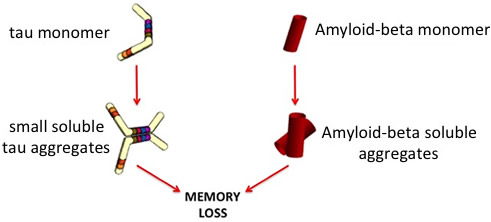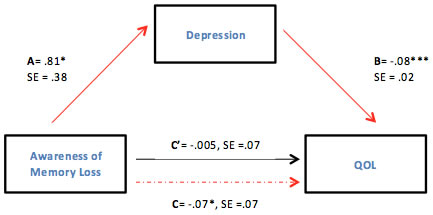Columbia University
Irving Medical Center
Neurological Institute
710 West 168th Street, 3rd floor
(212) 305-1818
TaubCONNECT Research Perspectives:
January 2016
» #2 Examining the Pathways Between Self-Awareness and Well-Being in Mild to Moderate Alzheimer Disease
» #3 Mediterranean Diet and Brain Structure in a Multiethnic Elderly Cohort
Extracellular Tau Oligomers Produce An Immediate Impairment of LTP and Memory
 |  |
| Ottavio Arancio, MD, PhD | Mauro Fá, PhD |
The prevailing hypothesis in the Alzheimer field is that the process leading to memory loss is initiated by soluble small aggregates of a peptide called amyloid-beta. This peptide would act onto another protein called tau that aggregates and spreads all over the brain. Most importantly, once amyloid-beta triggers tau pathology, the disease would progress independent of amyloid-beta. Therefore, therapies targeting amyloid-beta may not be effective once tau pathology is triggered. Nevertheless, there is data suggesting that the mechanisms of the disease might be more complicated than hypothesized. For instance, tau toxicity does not involve amyloid-beta pathology in tauopathies, suggesting that amyloid-beta is not necessary for tau pathology to occur, and pointing at the need to better clarify the relationship between tau and amyloid-beta.

FIGURE LEGEND: This study led by Dr. Ottavio Arancio provides direct evidence that extracellular tau oligomers impair memory and cell to cell communication, a requisite for a molecule playing a critical role in Alzheimer's disease.
Recently published in Scientific Reports is work from our laboratory (the Arancio Laboratory of the Taub Institute) that focuses on extracellular small soluble aggregates of tau and their role on memory and cell to cell communication, either by themselves or in combination with amyloid-beta. A brief exposure to extracellular tau aggregates produced memory loss and impaired cell to cell communication independent of the presence of amyloid-beta. Tau aggregates could also act in combination with amyloid-beta to produce these effects, as sub-toxic doses of the two peptides combined led to memory loss and impairment of cell to cell communication.
Taken all together, these findings demonstrate that tau and amyloid-beta small soluble aggregates produce common biochemical neuronal modifications relevant for molecular mechanisms of gene transcription involved in memory formation. This is important, in terms of translational significance, because the most compelling and relevant outcome from this study is that it has highlighted a new model for aggregate-induced toxicity in Alzheimer's disease, modifying the classical view that amyloid-beta triggers molecular modifications responsible for amnesic changes in the disease via tau. A unifying hypothesis for the disease origin is that small soluble aggregates of proteins involved in Alzheimer's disease, such as amyloid-beta and tau, are toxic, independent of the type of protein forming the aggregates. Therapies acting onto a common target (possibly in sites of interaction with the aggregates), or downstream of it, might therefore represent a valid and effective strategy for developing therapeutics.
Ottavio Arancio, MD, PhD
Associate Professor of Pathology and Cell Biology (in the Taub Institute)
oa1@cumc.columbia.edu
Mauro Fá, PhD
Adjunct Associate Research Scientist (in the Taub Institute)
mf2257@cumc.columbia.edu
Examining the Pathways Between Self-Awareness and Well-Being in Mild to Moderate Alzheimer Disease

Stephanie Cosentino, PhD
The vast majority of patients with Alzheimer's disease (AD) suffer from severe memory loss; however, only about half of patients with mild to moderate AD appear to be aware of their memory loss. Reduced self-awareness is a striking and consequential feature of the disease, impairing everyday decision making capacity for activities such as driving and medication management, thus threatening patient safety and autonomy. Disordered awareness also has broader implications for the family and society, increasing caregiver burden, and leading to greater use of Medicare home health services as suggested by recent data from our lab. Consequently, interventions to improve self-awareness in AD may have potential value. However, it is often suggested that efforts to preserve awareness would negatively affect key patient reported outcomes related to psychological well-being, potentially increasing depressive symptoms and reducing quality of life (QOL).
Thus, the goal of this study, recently published in The American Journal of Geriatric Psychiatry by Sarah Cines, Dr. Stephanie Cosentino, and colleagues at the Taub Institute was to directly examine the pathways between awareness and psychological well-being. We also tested three specific models by which awareness and depression may be linked including: 1) depression is the psychological reaction to being aware of one's memory loss; 2) depression exacerbates memory problems leading to increased awareness of such problems; and 3) depression leads to negative perceptions of various aspects of the self, leading to increased memory complaints (regardless of the true level of awareness). Results from this study were intended to inform strategies for managing and enhancing key patient reported outcomes in the lives of persons with AD. This will be increasingly important as disease modifying treatments are being developed that, if effective, will keep individuals at mild stages of dementia for longer periods of time.

Figure 1. Model 1: Does awareness influence depressive symptoms and quality of life?
Note. Lines in red represent significant pathways. Path A represents the pathway between the predictor and mediator; Path B refers to the effect of the mediator on the outcome after controlling for the effect of the predictor; and Path C’ refers to the direct effect of the predictor on the outcome after controlling for the effect of the mediator. The indirect effect reflects the product of Path A and Path B, and a significant indirect effect indicates some mediating effect. Finally, Path C, or the total effect, is the sum of the direct and indirect effects.
In collaboration with researchers at the University of Pennsylvania, we recruited 104 individuals with mild to moderate Probable AD through the Department of Neurology at Columbia University Medical Center and PENN Memory Center. We tested four mediation models using path-analytic approaches. For each mediation model, we estimated the total, direct, and indirect effects of a predictor on the outcome variable through the selected mediator. The results of the overall model (Figure 1) revealed direct paths between awareness and depression (A), and depression and QOL (B). Interestingly, there was no direct effect of awareness on QOL (C'); only an indirect effect through depression. For the three models examining the reasons that depression may be linked to awareness, mediators included: 1) self-rated distress surrounding specific cognitive failures; 2) memory functioning; and 3) self-ratings across a range of abilities. None of the three models demonstrated a significant mediation effect.
There were several novel and important findings of this study. While there was a link between awareness and depression, there was no direct link between awareness and QOL, only a path that was mediated by depression. Thus, memory awareness did not negatively influence peoples' perceptions of their "life as a whole" in the absence of depressive symptoms. In other words, it appears that depression, not awareness, was the key driver of QOL. This confirms the idea that alleviating depressive symptoms may bolster QOL in early AD, and suggests that being aware of one’s symptoms in early AD does not necessitate poor quality of life. A second novel finding was that depressed mood did not appear to be a psychological reaction to cognitive failures. In fact, none of the three hypothesized pathways between awareness and depression was supported, suggesting that awareness and depression may be driven by a third unmeasured factor such as the pattern in which neuropathology is distributed throughout the brain. Taken together, results suggest that efforts to improve awareness for the sake of enhancing decision making capacities, treatment compliance, and patient–family relationships would not directly reduce patients' psychological well-being. Rather, a combined effort to preserve awareness and manage depressive symptoms in early AD may have the overall effect of enhancing a number or important clinical and practical outcomes related to autonomy and QOL.
Stephanie Cosentino, PhD
Assistant Professor of Neuropsychology (in Neurology, the Gertrude H. Sergievsky Center, and the Taub Institute)
sc2460@cumc.columbia.edu
Mediterranean Diet and Brain Structure in a Multiethnic Elderly Cohort

Yian Gu, MD, MS, PhD
The Mediterranean diet (MeDi) has been recognized in epidemiologic studies of several different populations worldwide as one of the healthiest diets. Adherence to the MeDi has been shown to be associated with reduced risk of Alzheimer's disease and slower cognitive decline in the elderly. Brain atrophy or cortical thinning, measured using magnetic resonance imaging (MRI), has been suggested as an early indicator for neurodegeneration. However, little is known about the association between dietary factors and these brain structural markers.
In a study recently published in Neurology, Drs. Yian Gu, Adam Brickman, Nikolaos Scarmeas, and colleagues from the Taub Institute examined the relationship between MeDi and brain volumes and cortical thickness. In this cross-sectional study, high-resolution structural MRI was collected on 674 elderly (mean age 80.1 years) adults without dementia who participated in the Washington Heights-Inwood Community Aging Project (WHICAP). Dietary information was collected via a food frequency questionnaire. Total brain volume (TBV), total gray matter volume (TGMV), total white matter volume (TWMV), mean cortical thickness (mCT), and regional volume or CT were derived from MRI scans using FreeSurfer program. The study found that compared to lower MeDi adherence (0–4), higher adherence (5–9) was associated with 13.11 (p=0.007), 5.00 (p=0.05), and 6.41 (p=0.05) milliliter larger TBV, TGMV, and TWMV, respectively. Higher fish (b=7.06, p=0.006) and lower meat (b=8.42, p=0.002) intakes were associated with larger TGMV. Lower meat intake was also associated with larger TBV (b=12.20, p=0.02). Higher fish intake was associated with 0.019 mm (p=0.03) larger mCT. Volumes of cingulate cortex, parietal lobe, temporal lobe, hippocampus, and CT of the superior-frontal region were associated with the dietary factors.
Overall, this study found that among older adults, MeDi adherence was associated with less brain atrophy, with an effect similar to 5 years of aging. Higher fish and lower meat intake might be the two key food elements that contribute to the benefits of MeDi on brain structure.
Yian Gu, MD, MS, PhD
Assistant Professor of Neurological Sciences (in Neurology, Epidemiology and the Taub Institute)
yg2121@columbia.edu

